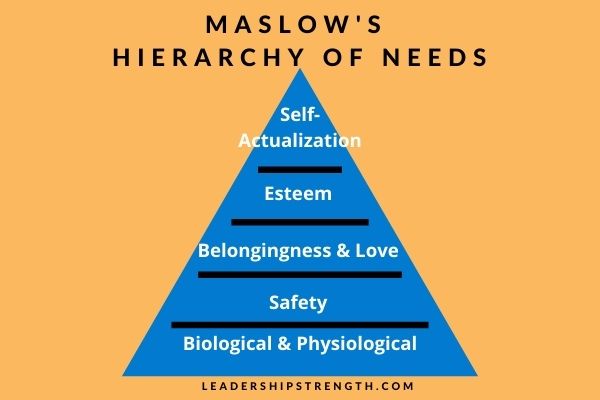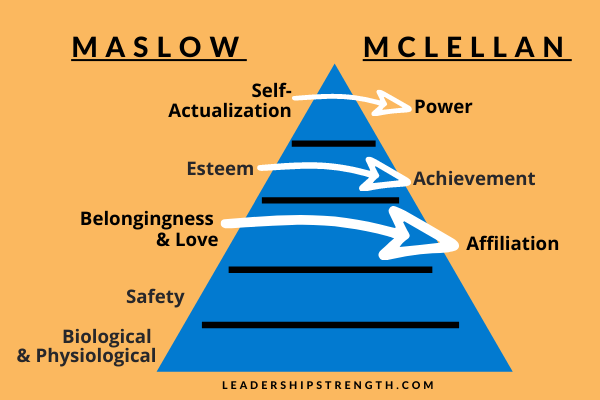Motivation theories abound.
But rather than rattling off a laundry list of theories, let’s focus on just two that will give you insight into what drives employee motivation.
Maslow’s Hierarchy of Needs
Abraham Maslow’s published his hierarchy of needs theory in 1943.
While some argue that there’s no evidence to support Maslow’s needs,1 many researchers, educators, and business leaders continue to cite this famous motivation theory to date.
Maslow’s theory asserts that people have five basic needs that motivate them. The most basic needs (biological and safety needs) are at the bottom, and the most advanced need (self-actualization) is at the top.2

Dar et al. provide examples of how Maslow’s hierarchy of needs apply to workplace motivation.3 Below, I have expanded on their examples to bring the point home.
- Biological and Physiological Needs – air quality, water, adequate breaks, temperature, the built work environment
- Safety Needs – safe work environment, personal and psychological safety, job resources, job security, stability, structure, freedom from threats (real and perceived)
- Love and Belongingness Needs – a sense of belonging at work, workplace friendships, trust, collaboration, team cohesion
- Esteem Needs – a sense of accomplishment, self-esteem, self-worth, feeling valued by others, being recognized, receiving positive feedback
- Self-Actualization Needs – achieving one’s full potential, development opportunities, career growth
According to Maslow, this hierarchy is progressive in nature. Therefore, the basic needs must be satisfied before the more advanced needs can motivate.4
For example, an employee who’s physically hurting from an ergonomically deficient workstation (safety) will not be as motivated by development opportunities (esteem) as someone who’s not suffering from similar conditions. When employees are hurting, personal growth and development are not necessarily top of mind.
All five needs in the hierarchy must be satisfied to unleash the full power motivation and drive the best possible performance.
Nearly two decades after Maslow published his Hierarchy of Needs theory, McClelland published a well-known needs theory of his own.
McClelland’s Need Theory
In his 1961 publication of The Achieving Society, McClelland proposed that three needs as the chief workplace motivators: power, achievement, and affiliation.5
Here’s a quick summary of the three.
The Need for Power
People with a high Need for Power seek power, control, and influence. They’re satisfied when they make a physical or emotional impact on others or the world. They hate social defeats or being controlled or influenced by others.”6
The Need for Affiliation
People with a high Need for Affiliation seek social relationships, group membership, love, and acceptance. They tend to get lonely if this need is not satisfied.7
The Need for Achievement
People with a high Need for Achievement focus on their own accomplishments. They value receiving regular feedback, fulfilling their responsibility, and achieving accomplishments as individuals.8
Alignment between Maslow and McClellan
McClellan’s theory, which was specifically developed for the workplace, aligns well with the top three rungs of Maslow’s Hierarchy of Needs.

While there may be some additional crossover between McClellan and Maslow’s theories, the table above illustrates strong alignment.
For instance, McClellan’s “affiliation” is impacted by Maslow’s “safety.” When people feel psychologically safe at work (Maslow’s “safety”), they can express what they really think without fear of negative consequences from their leadership, such as alienation or loss of relationship (McLellan’s “affiliation”). In other words, employees feel they can be authentic without loss of acceptance.
Regardless of how we slice the crossover between these two key theories, they both point to how needs drive employee employee motivation.
People are Unique
Because people are complicated and unique, we can’t compartmentalize their needs, regardless of the theory we’re using. People can simultaneously have more than one need, and their needs can change over time. Additionally, how these needs can be satisfied can be as unique as each person.
How to Assess the Motivators of Individuals
The Motivators Assessment can help you understand the needs that motivate individuals.
The Seven Facets of Motivation
The tool assesses seven fundamental and universal aspects of motivation:
- Aesthetic – Desiring balance, harmony, and coherence.
- Economic – Seeking a favorable outcome or profit.
- Individualistic – Striving to be distinctive and self-reliant.
- Power – Wanting control or authority.
- Altruistic – Being motivated by helping others, even if it means sacrificing personal interests.
- Regulatory – Seeking to establish organization, consistency, and order.
- Theoretical – Driven by a thirst for knowledge, learning, and comprehension.9
These dimensions of motivation exist in everyone but in uniquely varying degrees.
The bottom line is that needs drive motivation. To unleash employee motivation, we must identify people’s needs and implement tangible ways to meet them.
About the Author

SYLVIA MELENA is the Founder and Principal of Melena Consulting Group, a leadership and management consulting, training, and book coaching company. She is also the two-time international and #1 best-selling author of Supportive Accountability: How to Inspire People and Improve Performance and its Spanish translation, Responsabilidad solidaria.
REFERENCES: 1Isac, Florin-Lucian, “Cultural Influences and Work Motivation: A Literature Review.” Journal of Economics and Business Research 22, no. 1 (2016): 110-120. ://www.uav.ro/jour/index.php/jebr/article/view/696/pdf. Accessed 3/7/21. Creative Commons License: https://creativecommons.org/licenses/by/4.0/. 2Güss, C. Dominik, Madison L. Burger, and Dietrich D. Dörner. “The Role of Motivation in Complex Problem Solving.” Frontiers in Psychology, 8 (2017): 851. Doi: 10.3389/fpsyg.2017.00851 https://www.frontiersin.org/articles/10.3389/fpsyg.2017.00851/full. Accessed 3/7/21. Creative Commons License: http://creativecommons.org/licenses/by/4.0/. 3Dar, Aftab Tariq, Mohsin Bashir, Faheem Ghazanfar, and Muhammad Abrar. “Mediating Role of Employee Motivation Relationship to Post-Selection HRM Practices and Organizational Performance.” International Review of Management and Marketing 4, no. 3 (2014): 224 - 238. http://www.econjournals.com/index.php/irmm/article/view/864/pdf. Accessed 3/7/21. Creative Commons License: https://creativecommons.org/licenses/by/4.0/. 4Dominik C. Güss et al., "The Role of Motivation," 851. 5, 6, 7, 8 Jager, Sandra Doeze, Marise Born, and Henk Van der Molen. “Self-Other Agreement Between Employees on their Need for Achievement, Power, and Affiliation: A Social Relations Study.” Scandinavian Journal of Work and Organizational Psychology 2, no. 1 (2017): 9. doi: http://doi.org/10.16993/sjwop.29 https://www.sjwop.com/articles/10.16993/sjwop.29/. Accessed 3/7/21. Creative Commons License: https://creativecommons.org/licenses/by/4.0/. 8 Assessments 24 x 7 & Behavioral Resource Group, Motivators Assessment: https://leadershipstrength.com/wp-content/uploads/2020/11/Motivators_Sample-Report_Melena-Consulting-Group_11-5-2020.pdf







